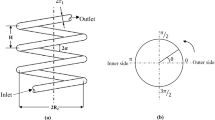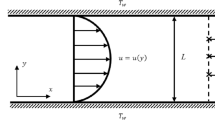Abstract
Heat flux at the boundary of a duct is estimated using the inverse technique based on conjugate gradient method (CGM) with an adjoint equation. A two-dimensional inverse forced convection hydrodynamically fully developed turbulent flow is considered. The simulations are performed with temperature data measured in the experimental test performed on a wind tunnel. The results show that the present numerical model with CGM is robust and accurate enough to estimate the strength and position of boundary heat flux.











Similar content being viewed by others
Abbreviations
- b :
-
Height of duct (m)
- c p :
-
Specific heat capacity of fluid [J/(kg K)]
- d :
-
Direction of descent, defined by Eq. 6
- k :
-
Thermal conductivity [W/(m K)]
- J :
-
Objective function, defined by Eq. 3
- l :
-
Length of duct (m)
- nx :
-
Numbers of control volume in x direction
- nx :
-
Numbers of control volume in y direction
- M :
-
Number of measured data
- P :
-
Heater input power (W)
- q :
-
Heat flux (W/m2)
- R :
-
Resistance (Ω)
- Re :
-
Reynolds number
- RTD:
-
Resistance temperature detectors
- T :
-
Temperature (K)
- T in :
-
Inlet temperature (K)
- u :
-
Velocity in x coordinate (m/s)
- V :
-
Voltage
- x, y :
-
Cartesian coordinate
- α :
-
Thermal diffusivity (k/ρcp) (m2/s)
- β :
-
Search step-size, defined by Eq. 8
- δ :
-
Dirac delta function
- ε :
-
Convergence criteria
- ε H :
-
Eddy thermal diffusivity (m2/s)
- γ :
-
Conjugation coefficient, defined by Eq. 7
- λ :
-
Lagrange multiplier
- ρ :
-
Density of fluid (kg/m3)
- σ :
-
Standard deviation of measurements
- σ P , σ V and σ R :
-
Uncertainties in power, voltage and resistance respectively
- ξ :
-
New space variable converting final value problem to initial value
- n :
-
Iteration number
- m :
-
Measurement location for a single sensor
References
Huang CH, Tsai CC (1998) An inverse heat conduction problem of estimating boundary fluxes in an irregular domain with conjugate gradient method. Heat Mass Transf 34:47–54
Zueco J, Alhama F, Fernández CFG (2005) Numerical nonlinear inverse problem of determining wall heat flux. Heat Mass Transf 41:411–418
Pourshaghaghy A, Kowsary F, Behbahaninia A (2007) Comparison of four different versions of the variable metric method for solving inverse heat conduction problems. Heat Mass Transf 43:285–294
Parwani AK, Talukdar P, Subbarao PMV (2013) Performance evaluation of hybrid differential evolution approach for estimation of the strength of a heat source in a radiatively participating medium. Int J Heat Mass Transf 56:552–560
Parwani AK, Talukdar P, Subbarao PMV (2013) Simultaneous estimation of strength and position of a heat source in a participating medium using DE algorithm. J Quant Spectrosc Radiat Transf (in press). doi:10.1016/j.jqsrt.2013.05.006
Das R, Mallick A, Ooi KT (2013) A fin design employing an inverse approach using simplex search method. Heat Mass Transf 49:1029–1038
Atchonouglo K, Banna K, Vallée C, Dupré JC (2008) Inverse transient heat conduction problems and identification of thermal parameters. Heat Mass Transf 45:23–29
Mehta RC, Tiwari SB (2007) Controlled random search technique for estimation of convective heat transfer coefficient. Heat Mass Transf 43:1171–1177
Huang CH (2002) An inverse geometry problem in estimating frost growth on an evaporating tube. Heat Mass Transf 38:615–623
Moutsoglou A (1990) Solution of an elliptic inverse convection problem using a whole domain regularization technique. AIAA J Thermophys Heat Transf 4(3):341–349
Huang H, Ozisik MN (1992) Inverse problem of determining unknown wall heat flux in laminar flow through a parallel plate duct. Numer Heat Transf Part A 21(1):55–70
Machado HA, Orlande HRB (1997) Inverse analysis for estimating the timewise and spacewise variation of the heat flux in a parallel plate channel. Int J Numer Methods Heat Fluid Flow 7:696–710
Li HY, Yan WM (1999) Estimation of wall heat flux in an inverse convection problem. J Thermophys Heat Transf 13(3):394–396
Li HY, Yan WM (2000) Inverse convection problem for determining wall heat flux in annular duct flow. J Heat Transf 122(3):460–464
Park HM, Lee JH (1998) A method of solving inverse convection problems by means of mode reduction. Chem Eng Sci 53(9):1731–1744
Raghunath R (1993) Determining entrance conditions from downstream measurements. Int Commun Heat Mass Transf 20:173–183
Hong YK, Baek SW (2006) Inverse analysis for estimating the unsteady inlet temperature distribution for two-phase laminar flow in a channel. Int J Heat Mass Transf 49:1137–1147
Bokar JC, Ozisik MN (1995) An inverse analysis for estimating the time-varying inlet temperature in laminar flow inside a parallel plate duct. Int J Heat Mass Transf 38:39–45
Parwani AK, Talukdar P, Subbarao PMV (2012) Estimation of inlet temperature of a developing fluid flow in parallel plate channel. Int J Therm Sci 57:126–134
Parwani AK, Talukdar P, Subbarao PMV (2014) Estimation of transient boundary flux for developing flow in parallel plate channel. Int J Numer Methods Heat Fluid Flow 24(3):522–544
Parwani AK, Talukdar P, Subbarao PMV (2014) A hybrid approach using CGM and DE algorithm for estimation of boundary heat flux in a parallel plate channel. Numer Heat Transf Part A 65:461–481
Lin TW, Yan WM, Li HY (2007) Inverse problem of unsteady conjugated forced convection in parallel plate channels. Int J Heat Mass Transf 51:993–1002
Liu FB, Ozisik MN (1996) Inverse analysis of transient turbulent forced convection inside parallel plate ducts. Int J Heat Mass Transf 39(12):2615–2618
Li Y, Yan WM (2003) Identification of wall heat flux for turbulent forced convection by inverse analysis. Int J Heat Mass Transf 46:1041–1048
Su J, Lopes AB, Silva Neto AJ (2000) Estimation of unknown wall heat flux in turbulent circular pipe flow. Int Commun Heat Mass Transf 27:945–954
Su J, Silva Neto AJ (2001) Simultaneous estimation of inlet temperature and wall heat flux in turbulent circular pipe flow. Numer Heat Transf Part A 40:751–766
Chen CK, Wu LW, Yang YT (2006) Comparison of whole-domain and sequential algorithms for function specification method in the inverse heat transfer problem of laminar convective pipe flow. Numer Heat Transf Part A 50(10):927–947
FLUENT, User’s Guide 6.3, Fluent Inc., USA
Ozisik MN, Orlande HRB (2000) Inverse heat transfer: fundamentals and applications. Taylor and Francis, New York
Hunt IA, Joubert PN (1977) Turbulent flow in a rectangular duct. In: Proceedings of the 6th Australasian hydraulics and fluid mechanics conference Adelaide, Australia, pp 403–406
TESTO India Private Limited, www.testo.in
Holman JP (1994) Experimental methods for engineers, 6th edn. McGraw-Hill, New York
Author information
Authors and Affiliations
Corresponding author
Rights and permissions
About this article
Cite this article
Parwani, A.K., Talukdar, P. & Subbarao, P.M.V. Estimation of boundary heat flux using experimental temperature data in turbulent forced convection flow. Heat Mass Transfer 51, 411–421 (2015). https://doi.org/10.1007/s00231-014-1421-2
Received:
Accepted:
Published:
Issue Date:
DOI: https://doi.org/10.1007/s00231-014-1421-2




